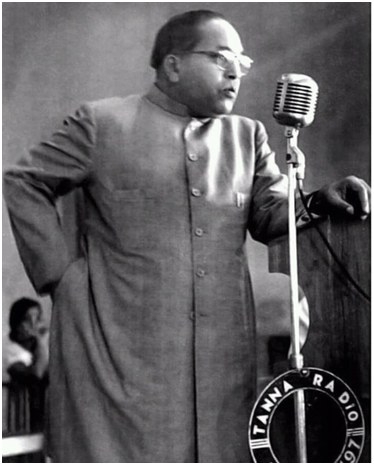Scott R. Stroud
Bhimrao Ambedkar is a complex figure who has many stories orbiting about him, many still waiting to be told and explored. I have become enraptured by the story we all know is there—that of the intellectual relationship between Bhimrao Ambedkar and John Dewey. Dewey was a giant in American philosophical stories; Ambedkar was a force of unique magnitude in Indian philosophical and political contexts. Both are complex thinkers, and Ambedkar acknowledged his “debt” to Dewey, his beloved teacher at Columbia University, right after learning of Dewey’s death in 1952. But here is where the story always ends. No one goes into details about these two figures. In the digging in archives and in Ambedkar’s own books and writings that grounds my recent book, The Evolution of Pragmatism in India, I have found there is much more to this story that must be told. It’s a story of Ambedkar as a student, Ambedkar as a creative thinker, and Ambedkar as a pragmatist philosopher in his own right.

A vital part to how I tell this story—what we focus on in Ambedkar’s life and thought is a choice that allows for much flexibility, after all—emphasizes a term that few others include when they analyze Ambedkar: rhetoric. Indeed, I give Ambedkar’s “rhetoric of reconstruction” a primary place in my account, since I see his reconstructive method playing out so prominently in how he argues and how he attempts to persuade others.
Isn’t “rhetoric” manipulation, some have asked? What such a reaction is asserting is simple–isn’t it demeaning to associate Ambedkar with manipulation? This objection rests on a simplistic and inaccurate depiction of what rhetoric means, and what it can mean.
In the west, we have departments, associations, courses, and degrees in rhetoric. The tradition summoned by most of these academic entities is the rhetorical tradition tracing back to ancient Greece, usually to the sophists, and continuing into Rome with thinkers like Quintilian and Cicero and beyond. “Rhetoric” usually, but not only, means for the western tradition the art of persuasive speaking. Now, we count more modalities of communication than oratory, and more traditions like India and China are being included in what’s studied, but the idea is the same: how can we use language to get our points across in the most effective way possible? What ethical choices or tradeoffs are involved in such uses of persuasive communication? In many cases, we want belief change, so the question becomes one of persuasion of our specific readers or listeners.
One catchy way of putting the art of rhetoric comes from Donald C. Bryant, who defined rhetoric as “the function of adjusting ideas to people and people to ideas.” Approaches to rhetoric now go far beyond this way of explaining it, but it’s still an effective entry point into what rhetoric includes. It’s not just about lying, although that is one extreme choice in adjusting how we put our points to an audience; we could also say just what our audience wants to hear, a choice that Plato fixated on in his dialogue, Gorgias, which lambasted the Greek teachers of rhetoric like Gorgias for teaching the knack for flattering one’s audience.
But extreme or abusive cases of how we use language do not mean that all language use is like that, or that the study of language is only oriented toward those extreme cases. Rhetoric in practice and in its theories is not about how to lie or flatter. How we argue and write and speak all implies choices; these choices are often ethical in how they reflect on what we think of ourselves and how we think of our audience.
Ambedkar as Rhetor
When I say Ambedkar was a rhetor, I am drawing attention to his activities as a persuasive communicator, and the skill or art he uses in communicating. As we should recognize, persuasion in its best, most lasting, senses do not involving lying, manipulating, or flattering one’s audience. Ambedkar did none of these things.

What he did do was exert extreme care in thinking about how he made his points to the audience that was likely to hear them. He spoke in a different way to his fellow Dalits who heard his 1936 appeals in “What Way Emancipation?” (Mukti Kon Pathe?) than he did in the prepared speech text we know as “Annihilation of Caste.” He had different goals, his audience had different interests and capacities, and his choices in language echoed all of these differing factors. This is what we are attending to when we consider Ambedkar as a figure of rhetorical interest.
What we gain by considering Ambedkar’s Rhetoric
When we consider Ambedkar’s rhetoric, we are attending to the way he makes choices in how he brings points to the foreground. We also consider who he might be speaking to and what he hopes to gain by putting the message in this way. Both of these emphases reveal aspects to Ambedkar’s thought and activism that we miss if we assume that his thought is one seamless whole in his head—one philosophy—and that each speech, letter, or book he utters is simply a consistent piece to that larger puzzle. Great thinkers, great leaders are rarely that consistent or single-purposed, especially across all the periods of their lives. Ambedkar is no exception to this rule.
The focus “rhetoric” brings is useful for making sense of parts of his thought that do not always go together without some tension. For instance, in his “What Way Emancipation?” speech, he aims to motivate and convince a crowd of oppressed Dalits that they should believe in themselves, and in their ability to do something about their fate in their choice of religion. He sees the achievement of self-respect as essential to the demands of respect from others. His message emphasizes these aspects to converting from or out of Hinduism.
In “Annihilation of Caste,” however, he seems to construct his message to push the “upper caste” reformers of the Jat Pat Todak Mandal—a crowd that is largely “on his side”—to their limits. There, he writes of dynamiting the shastras and an easily missed distinction of destroying religions of rules (but not religions of principle). He is clearly not flattering his audience of higher-caste reformers, but he is making specific and purposeful choices in how he formulates his arguments and appeals.

Ambedkar’s purposes in “Annihilation of Caste” are revealed in his passage on reflective thought, a topic and skill that both Ambedkar and Dewey placed a lot of emphasis. We know that Ambedkar saw this point about reflective thinking resolving or bringing order to a “problematic situation” in Dewey’s texts—Ambedkar the reader placed some of his characteristic checkmarks next to a passage on this theme in his 1929 copy of Dewey’s Experience and Nature.
Not all of life is problematic, however, but the parts that are call out for reflective and creative thinking. This was a theme that Ambedkar’s own rhetorical practice works with in “Annihilation of Caste.” For instance, in talking about how individuals react to caste, Ambedkar indicates:
“Man’s life is generally habitual and unreflective. Reflective thought, in the sense of active, persistent and careful consideration of any belief or supposed form or knowledge in the light of the grounds that support it and further conclusions to which it tends, is quite rare and arises only in a situation which presents a dilemma—a crisis.”
Certain situations in life can be problematic (Dewey’s term) or present a crisis or dilemma (Ambedkar’s way of putting it). This applies to Ambedkar’s search for housing or other experiences of caste oppression that drove home the unnaturalness and oppression of caste, but it can also apply to the experience his audience has in hearing his speech and his appeals. Certain ways of speaking can create a crisis or dilemma for those who hear it. That’s what a focus on rhetoric allows us to see—Ambedkar was attempting to create a crisis for this small audience of reformers concerning how far they were willing to go to take caste reform seriously.
As we know, his rhetorical choices in making his argument the way he did in “Annihilation of Caste” did create a crisis—one so big that his speech was cancelled before he had the chance to give it. In that shock came a larger afterlife of “Annihilation of Caste” as a printed text, read by followers and opponents like Gandhi alike. But a focus on the rhetorical aspects of his speech and its planned situation open up new questions to explore, such as why Ambedkar chose to treat friendly, but perhaps complacent, caste reformers in such a harsh way. One could also ask similar questions about how Ambedkar calibrated his appeals to the “Hindu masses” in his controversial text, Riddles in Hinduism. Thinking through and with the category of “rhetoric” brings all of these questions to the foreground.
Rhetoric as an Opening
The point I want to emphasize is that we have our own choices in how we look at Ambedkar, and how we think and write about him. By sometimes thinking about him as a rhetorical figure, we can do justice to his unusual skill at speaking and writing in a powerful fashion and explore the ways that rhetoric plays a role in his anti-caste advocacy. We don’t need to artificially close down new ways of thinking about Ambedkar by illogically assuming “rhetoric” only means “communication meant to mislead or manipulate.” Persuasive speech, like Ambedkar demonstrates in his many appeals to his fellow Dalits to convert, can be truthful, respectful, and powerful.
We know for a fact that John Dewey, as admired as he was by Ambedkar, was an incredibly boring speaker—both in his classes and on the podium. Ambedkar was different. He was powerful and eloquent. He had a message and he crafted that message to show respect for his purposes, his mission, and the audiences that heard it. This respect even extended to his enemies.
In discussing the value and risks of the art of speech at the award ceremony for a 1948 Siddharth College speaking contest, Ambedkar shows how his view of speech mixes with his view of democratic practices. After praising Indian orators such as Gopal Krishna Gokhale and Pherozeshah Mehta and non-Indian orators like Winston Churchill, Ambedkar moves beyond the idea of speech as just implying a lot of practice. Rhetoric or speaking also entails a choice of how you view those you speak to—including your opponents. He tells the assembled students that kings or tyrants
“need not pay any attention to eloquence because his will is law. But in a parliament where laws are made, no doubt by the wishes of the people, the man who succeeds in winning our opposition is the man who possesses the art to persuade his opponent. You cannot win over a majority in this House by giving a black eye to your opponent… You will have to carry a proposition only by the art of speaking, by persuading [your] opponent, by winning him over his side by argument, either gentle or strong, but always logically and instructively.”
Respect was a central concern for Ambedkar. It was what was needed for him and his fellow Dalits. It’s what he tried to instill in his followers that heard his appeals. And it even mattered when one chooses how to engage their enemies using the force of persuasion. How we argue and construct our messages implicated what we thought of ourselves—and of those we directed the messages at. Ambedkar holds many things for us to learn about the ethics and parameters of language use and rhetoric, but only if we’re open to asking the questions that reveal these lines of inquiry.
~~~
Scott R. Stroud is an associate professor of communication studies at the University of Texas at Austin. He is the author of The Evolution of Pragmatism in India (HarperCollins India / University of Chicago Press, 2023) and co-founder of the first “Center for John Dewey Studies” in India at Savitribai Phule Pune University.










